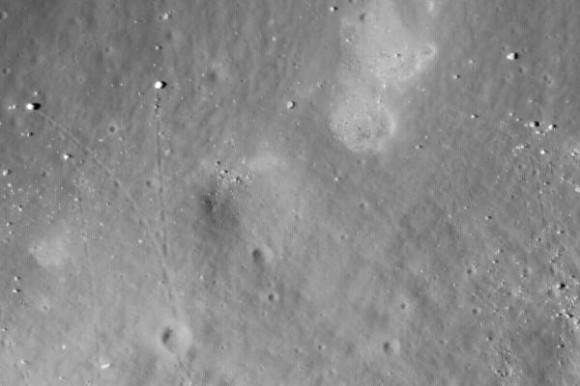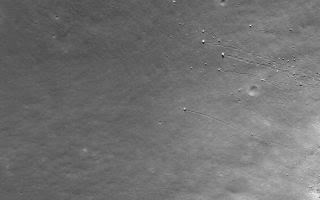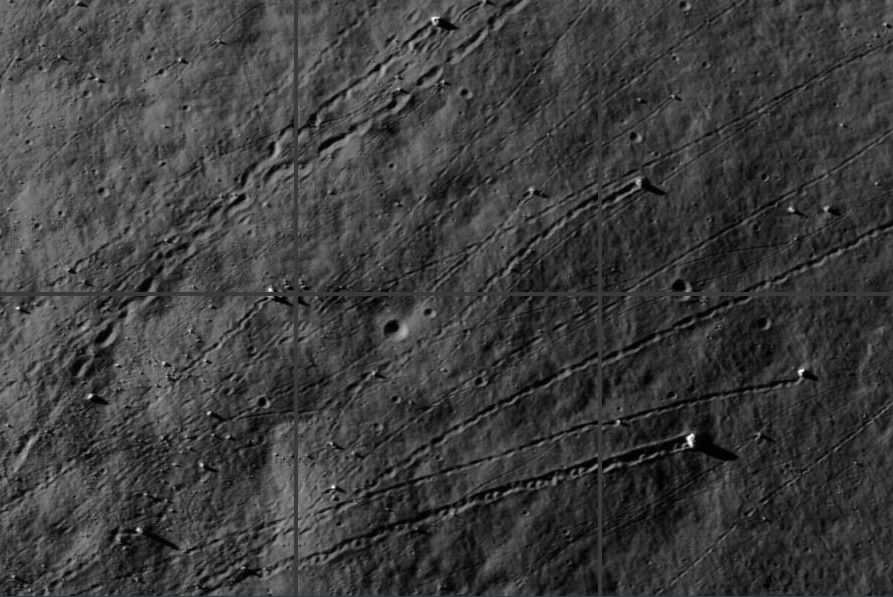[/caption]
There’s probably a great story in this image, if only someone was there to witness it as it happened! This is an image from Moon Zoo, the citizen science project from the Zooniverse that asks people to look at images from the Lunar Reconnaissance Orbiter and search for craters, boulders and more. And often, the Zooites find some very interesting features on the Moon, like this one and the ones below that include tracks from rolling, bounding, tumbling and sometimes bouncing boulders. Then the task for the scientists is to figure out what actually happened to get these boulders moving — was it an impact, are the boulder on the bottom of a hill, or was it some other unknown catalyst? As Zooniverse founder Chris Lintott says, “The Moon has its own landscape that is really quite dramatic, so it’s a world well worth exploring.”

Why look for tumbling boulders? Moon Zoo scientist Dr. Katie Joy gave this explanation:
“One of the main reasons we are asking Moon Zoo users to search for scars left behind by tumbling boulders is to help support future lunar exploration initiatives. Boulders that have rolled down hillsides from crater walls, or massifs like the Apollo 17 landing site, provide samples of geologic units that may be high up a hillside and thus difficult to access otherwise by a rover or a manned crew vehicle. If mission planning can include traverses to boulders that have rolled down hills, and we can track these boulders back up to the part of hillside from where they have originated, it provides a neat sampling strategy to accessing more geological units than would have been possible otherwise… Thus we hope to use Moon Zoo user data to produce a map of known boulder tracks (and terminal boulders) across the Moon.”

See more unique boulder tracks images in the Moon Zoo forum thread on boulders.
If you want to join in on the fun of looking for mysteries on the Moon, check out Moon Zoo, or the Zooniverse for more citizen science projects where you can get involved in helping scientists do real science.


I am wondering if these boulders could start rolling downhill triggered by an moonquake. I know that presently the moon has no geologic activity, but perhaps, before it cooled down completely, at some time in the past, there was something on the moon similar to the tectonic plates on Earth (I expect that the moon had a time in the past when the outer layers were relatively cold, while below the surface magma was still flowing).
Quasy, for plate tectonics to happen you need one thing the Moon mostly lacks: water. Plenty of it. So nope.
Still, you don’t need plate tectonics or volcanism to have quakes, and there are moonquakes to this day. Stresses from tidal forces sometimes cause ruptures and impacts tend to put the Moon ringing like a bell. So it’s very possible indeed that these boulders started moving due to those quakes.
These boulders could have been there for a few millions of years by now. No atmosphere so the dust can be undisturbed very old.
and Einstein said God doesn’t play dice
Looks like Einstein was wrong – God does play dice…
damn duplicates
I thought it was common knowledge that these features were from the close passage of the alien mothership in Independence Day! Sheesh, rent the movie already. 😀
I’ve been going into the MooNZoo for several months now and have found about a half dozen images with boulder tracks. Those and fresh white craters are my favorites! It WOULD be way double extre groovy cool to find a volcanic tube entrance~ By far, the neatest thing I’ve seen in there was a very strange series of craters. They were on a diagonal track from top to bottom of the image and were exactly the same size and exactly equally spaced and shared a single ‘track’ which made me think it was either a crater chain, boulder track or? I wrote Jules (One of the site moderators) @ the MooNZoo and sent what I THOUGHT was a ‘favorite’. Unfortunately that image did NOT appear to have been captured correctly(S), so Jules forwarded me to one of the sites techies who captured ALL of the images I’ve examined so far in an Excel spreadsheet that I might go back and find that image again. So far I’ve gone back thru 700 of the 3,000 or so images I’ve characterized, but haven’t found it yet… Tell you what… IF and WHEN I do find it, I’ll send along a copy to UT so you guys can check it out and see what I mean when I say ~ It was VERY strange….
Looks eerily like the sailing stones of Darth Valley. Which are quite eerie in their own right.
That’s superfluous, they would gather no moss anyway.
“Tumbling Boulders” sounds like a great name for a Stones tribute band.
This article mentions that some boulders might be explored and save the effort of climbing back to where they came from? oTay… so long as poking around doesn’t set it in motion again! Like – “OWIE! My TOe!”
@William928 – ROTFL! Yeah… maybe they’d do a cover called, “Midnight Rumbler”? or “Its only Rock and Roll!” ??? – Grins and lets himself out of the studio..
Moon faults are visible in the lower elevations of the Vallis Alpes, which is 7 miles across and 79 miles long. The Vallis Alpes is a basin covered with basaltic lava flows, which are not caused by tectonic plates sliding across each other melting rock in undersea subduction zones like on earth. Seismic activity is extremely weak on the moon without any tectonic plates in motion. This leads most to believe that 3.9 billion years ago, an asteroid 4,000 km diameter impact is responsible for forming the Montes Alpes and Vallis Alpes. The Montes Alpes reaches elevations up to 7,300 feet, but is not built by plate tectonics. It too is basaltic lava, which likely was molten magma rising, that rapidly cooled shortly after the asteroid impact. There is practically no erosion on the lunar surface, so when magma fractures along weak mineral planes elevated at angles that build up tension pressures, basaltic lava boulders break apart, and leave trails when they roll down on the valley, from higher elevations in the montes alps. This is my theory as a degreed geologist that best supports the facts and evidence as the mostly likely cause.